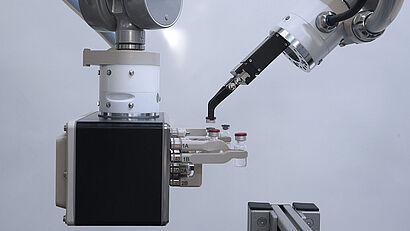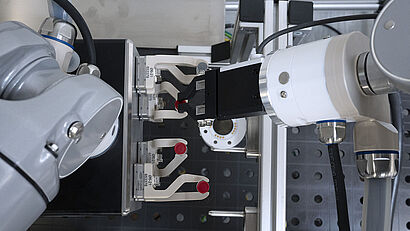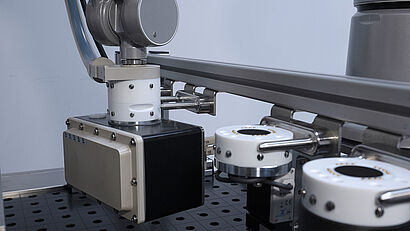Flexibility in pharmaceutical production
Aseptic tool changer for automated processes
Automated processes in the pharmaceutical industry are complex and demanding. Particularly in the aseptic environment, as is the case in the pharmaceutical fill and finish area, the machines must offer the highest precision and reliability. Conventional automation systems reach their limits here.
Challenges in aseptic production
The specific requirements for machines in the pharmaceutical industry, such as sterility, handling of highly potent active ingredients and flexibility in production, demand innovative solutions. A key problem was that different gripping systems were required for different applications, but due to the geometry, the travel distances and the high mass, these could not be integrated into one system. The machine design must meet high cleanliness requirements, which further increases the complexity. One of the main objectives was to use the aseptic tool changer to pave the way for machine concepts without manual intervention.
Robot systems are a crucial element in the production systems of the filling and packaging machine manufacturer Bausch+Ströbel. For example, the Stäubli TX2-60 stericlean+ robot system with a nominal load capacity of 3.5 kg is used in numerous applications. If the nominal load is exceeded, the robot's speed and acceleration have to be reduced, which in turn reduces the performance of the applications. The obvious solution is to use a tool-changing system or a less flexible system for changing gripper jaws.
However, these conventional systems use bayonet locks or pressure pieces that are difficult to clean. And changing the gripper jaws often means that contours cannot be sufficiently decontaminated.
Due to the cramped cleanroom conditions and the complex pharmaceutical processes with varying requirements, which range from small individual glass objects to machine equipment, in the past different gripper systems had to be integrated into one housing, resulting in large and heavy tools. The disadvantage of combined gripper systems was the protruding contour and the suboptimal use of the individual gripper systems, which resulted in cost-intensive design and simulation work. ‘The aim was to increase the performance of robot systems and to be able to react flexibly with little modification effort to, for example, changes in official requirements or customer requests,’ explains Philipp Wimberger, Group Leader Software / Electrical Engineering at Bausch+Ströbel.
The solution: aseptic tool changer
To meet these challenges, Zimmer Group has developed an aseptic tool changer in close cooperation with Bausch+Ströbel. This tool changer offers a number of other advantages in addition to its comparatively lightweight design, and lays the foundation for flexible, efficient and safe automation solutions in the pharmaceutical industry.
The tool changer is able to accommodate and operate various electric, servo-electric and pneumatic gripping systems. One particular advantage of the tool changer is its versatility. It can pick up heavy format parts directly or take over additional process steps such as cleaning with a cleaning pistol fully automatically. Measuring devices for validation and qualification can also be attached without difficulty. The tool changer is designed with a 7-fold coding system, thus different workpieces are easily recognised.
Safety is the top priority in pharmaceutical production. In the event of a power failure, a permanent electromagnet ensures that no hazardous situation arises, no product is lost and production can resume later. The electrical contact is made via gold-plated stainless steel contacts, in which each individual contact and the spring travel have been equipped with a pharmaceutical-grade seal in accordance with hygienic design specifications. ‘A great solution and implementation by Zimmer Group for the challenges in pharmaceutical engineering,’ says Philipp Wimberger.
Quality improvement through reproducibility
One much-discussed topic in the pharmaceutical industry, for example, is the automatic cleaning of the system after processing highly effective products. The state of the art involves cleaning processes that are carried out by operators according to standard operating procedures. A spray gun is introduced into the machine and an operator cleans the machine through a glove port according to a predefined system. ‘By using the tool changer to pick up the spray gun and the automated cleaning movement, a higher level of reproducibility is achieved compared to manual cleaning, thus increasing quality,’ explains Wimberger.
The tool changer system is fully GMP compliant in terms of both materials and design. This makes it ideal for the bio-decontamination process and for wash-in-place (WIP) cleaning after filling with highly potent substances.
Perfect cooperation leads to innovation
The collaboration between Zimmer Group and Bausch+Ströbel was characterised by inventiveness and technical expertise. Both companies combined their skills to develop a customised solution that meets the specific requirements in the pharmaceutical environment. The tool changer makes it possible to respond to the required application without making any compromises.
The use of the aseptic tool changer means that in the future, systems will no longer need to be completely rebuilt when modifications or a change of production are required. This saves costs and space, minimises the risk potential and at the same time increases the flexibility of the pharmaceutical end customer.
The customised solution is now being added to Zimmer Group's portfolio as a standard product in the WMR2000 series, making it available to other customers who want to benefit from the advantages of this innovative technology.
Conclusion: the aseptic tool changer is the optimal solution for the challenges of modern pharmaceutical automation. It combines maximum flexibility, safety and efficiency, making it an important building block on the road to the smart factory in the pharmaceutical environment. The successful collaboration between Zimmer Group and Bausch+Ströbel shows how partnerships can lead to innovative and sustainable solutions.



